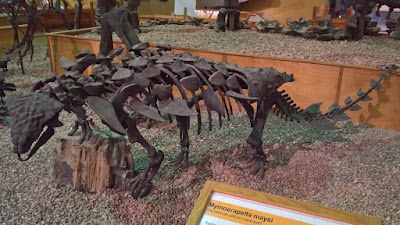Mymoorapelta maysi, the Shield of Mygatt-Moore Quarry
In my previous post about Dracopelta, I alluded to two other ankylosaur taxa from the Late Jurassic, Mymoorapelta
maysi and Gargoyleosaurus parkpinorum, both from the Morrison Formation, USA. Since the Lourinhã and Morrison formations are coeval and the similarities between the faunas are many, particularly dinosaurs (e.g. Torvosaurus, Supersaurus, Allosaurus, Ceratosaurus, Stegosaurus), I thought it would be interesting to shed a little light on the Late Jurassic American ankylosaurs. Therefore, I'll dedicate the next posts to this topic, starting with Mymoorapelta
maysi (Figure 1), the Mygatt Moore armored conundrum.
 |
Figure 1: Mymoorapelta maysi reconstruction at the Wyoming Dinosaur Center, Thermopolis, Wyoming, USA. Photo by João Russo.
|
Ankylosaurs from the Late Jurassic are quite rare. Besides Dracopelta zbyzewskii from Portugal, two
other taxa are accepted based on fairly complete specimens: Gargoyleosaurus parkpinorum Carpenter,
Miles & Cloward 1998, and Mymoorapelta
maysi Kirkland & Carpenter 1994, both from the Morrison Formation, USA.
Naish & Martill (2008) also recognized a right femur from Oxfordian of
England as belonging to Ankylosauria, putatively Cryptosaurus eumerus Seeley 1869 (previously Cryptodraco eumerus Lydekker 1889). The American taxa exhibit many
features that are observed in later, more derived ankylosaurs: extensive
cranial ornamentation, horizontally oriented ilia, partial or total closure of
the acetabulum, and a wide, low-slung body (Arbour & Currie, 2015).
Mymoorapelta maysi was first described in 1994 by Kirkland & Carpenter, based
on several postcranial elements recovered from the Mygatt- Moore Quarry. In
fact, the etymology of the name, “small shield of Mygatt-Moore”, honors the
discoverers of the site, Peter and Marilyn Mygatt, and John D. and Vanetta
Moore; “pelta” is Greek for a small
shield used in Ancient Greece. The specific epithet “maysi” refers to Chris Mays, president of Dinamation International
Corporation, and founder of the Dinamation International Society, which funded
the research.
At the time, M. maysi was the first ankylosaur described from the Jurassic of
North America, and only the second known from fairly complete material, the
other being Tianchiasaurus from the
Middle Jurassic of China (Dong, 1993; Kirkland & Carpenter, 1994). The
material, collected in the Brushy Basin Member of the Morrison Formation,
consists of the holotype (MWC 1815), a complete left ilium, and paratypes, consisting
of all the material associated with the holotype and probably from the same individual:
left jugal, vertebrae, ribs, limb bones, osteoderms and spines (Kirkland &
Carpenter, 1994; Kirkland et al., 1998). The material is stored at the Museum
of Western Colorado, Grand Junction, CO, USA.
The material from M. maysi reveals some interesting features, some plesiomorphic
while others are shared with more derived ankylosaurids and nodosaurids. The
presence of solid dorsal scutes, seemingly a basal character shared with nodosaurids,
is counterposed by a number of hollow scutes, such as the ones in the sacral
shield, which are also found in Ankylosauridae. Another example is the jugal
horn present in M. maysi, similar to
what is observed in ankylosaurids. The armor ornamentation, however, appears to
be less derived than in ankylosaurids, and more similar to what is found in
basal nodosaurids or intermediate forms of ankylosaurs (Kirkland &
Carpenter, 1994; Kirkland et al.,
1998). The fused sacral shield, triangular caudal plates with asymmetrical
hollow bases, and posteriorly grooved shoulder spines are characters shared
with Polacanthus and other Early
Cretaceous ankylosaurs (Kirkland & Carpenter, 1994; Kirkland et al., 1998;
Arbour & Currie, 2015). One other interesting aspect of this specimen was that the fusion of vertebral elements was complete with no evidence of suture, usually an ontogenetic trait. This indicates that the individual was an adult and, at the time of the discovery, was the smallest quadrupedal dinosaur known from the Morrison Formation (Kirkland & Carpenter, 1994). Based on the length of ilium, Mymoorapelta would probably reach approximately 3 meters in length.
This mix of derived and basal characters makes
the exact positioning of M. maysi within
Ankylosauria uncertain. Furthermore, the lack of overlap in some of the more
diagnostic material, namely cranial elements, in many of these taxa adds to the
uncertainty. At the same time, the combination of these characters makes Mymoorapelta an important taxon in
phylogenetic analyses and in the evolutionary of the Ankylosauria and its
members. Together with its Late Jurassic age, the evolutionary and paleobiogeographic
implications can prove to be very significant and offer insight into the origin
and dispersal of the group.
Arbour, V. M., and P. J. Currie. 2015.
Systematics, phylogeny and palaeobiogeography of the ankylosaurid dinosaurs.
Journal of Systematic Palaeontology, 14(5): 385-444.
Carpenter, K., Miles, C., and K. Cloward. 1998. Skull of a
Jurassic ankylosaur (Dinosauria). Nature, 393: 782-783.
Kirkland, J. I., and K. Carpenter. 1994. North America's first
pre-Cretaceous ankylosaur (Dinosauria) from the Upper Jurassic Morrison
Formation of Western Colorado. Brigham Young University Geology Studies, 40:
25-42.
Kirkland,
J. I., Carpenter, K., Hunt, A. P., and R. D. Scheetz. 1998. Ankylosaur
(Dinosauria) specimens from the Upper Jurassic Morrison Formation. Modern Geology, 23: 145-177.
Lydekker, R. 1889. On the remains and
affinities of five genera of Mesozoic Reptiles. Quarterly Journal of the
Geological Society, 45: 41-59.
Naish, D., and Martill, D. M. 2008. Dinosaurs of Great Britain
and the role of the Geological Society of London in their discovery:
Ornithischia. Journal of the
Geological Society, 165(3):
613-623.

Comments
Post a Comment